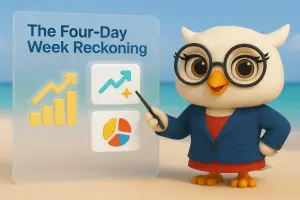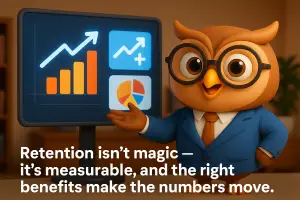Introduction: Make Benefit ROI Visible
Benefits matter—but without numbers, they look like cost. If your execs ask, “What’s the return?”, this guide shows how to calculate benefit ROI step-by-step and model outcomes with our free Employee Benefits ROI calculator. You’ll walk away ready to defend budgets and expand what’s working.
Try it now: Employee Benefits ROI Calculator
1) Why Benefit ROI Matters
When leaders can see the ROI of employee benefits, decisions get easier. Transparent ROI links programs to outcomes: lower turnover, faster hiring, better engagement, reduced absenteeism, and a stronger employer brand.
- Boards expect evidence, not anecdotes. See context from SHRM.
- Turnover and engagement as cost levers from Gallup.
2) The Basic ROI Formula (and what to count)
Formula: ROI = (Gains – Costs) ÷ Costs × 100%
Gains you can attribute to your program:
- Reduced turnover (replacement & vacancy costs)
- Higher productivity / fewer sick days
- Lower recruiting & onboarding spend
- Discounts that reduce employees’ real cost of living (perceived value → retention)
Helpful primers:
- CIPD guide on evaluating wellbeing outcomes
- Harvard Business Review on flexibility as a performance driver
3) Which Benefits Typically Return the Most
- Mental health & wellbeing programs often show early ROI and improve over time (see Deloitte Human Capital).
- Financial wellbeing & cost-of-living support (discounts, budgeting education)
- Flexibility & remote/hybrid support (HBR above)
- Everyday retail discounts that convert to weekly savings and “felt value”
4) Model Your Numbers in Minutes (Free Calculator)
Our calculator models scenarios like “5% lower turnover” or “$X cost per hire” by letting you adjust plan tier, headcount, and promotion effort (plus optional comms). Enter your data, tweak assumptions, and instantly see benefit ROI to build your business case.
Does it show “With vs Without”?
Not as a single toggle. Instead, you create two quick scenarios and compare:
- Scenario A (baseline): choose a lighter promotion level and/or turn off lifestyle categories you don’t plan to include.
- Scenario B (program case): increase promotion (e.g., reminders + intranet post), include more categories, or change tier.
The dashboard recalculates participants, total savings, ROI%, break-even take-up, and payback—so you can compare A vs. B in seconds.
👉 Use the calculator
Need a walkthrough or want us to tailor assumptions? Book a 20-minute chat.
5) Tips for Better Measurement & Buy-In
- Use realistic benchmarks (industry, function, location).
- Compare scenario snapshots across 6–12 months (e.g., Baseline vs. Program Case).
- Show the trail of evidence: adoption → redemption → savings → retention.
- Visualise the story with simple charts your CFO will love.
- Report quarterly and reallocate to winners.
Further reading:
- MIT Sloan Management Review on connecting people metrics to value
- OECD on productivity & wellbeing
What We Offer (Internal Links)
- How It Works — platform, onboarding & reporting
- Employee Benefits Program — curated perks & ROI reporting
Mini-Checklist: Ready to Present Benefit ROI?
- Baseline KPIs (turnover %, time-to-fill, absenteeism, engagement)
- Program costs itemised (platform, comms, incentives)
- Adoption & redemption data
- Two scenarios from the calculator (Baseline vs. Program Case)
- One-page summary for leadership
FAQ: Benefit ROI
Q1. What’s a good ROI of employee benefits?
It varies by industry and goals. Many organisations aim for positive ROI within 6–12 months, with compounding returns as adoption grows.
Q2. How do I attribute savings to benefits?
Track activation → usage → outcome. For turnover, apply your cost-to-replace and compare matched cohorts “before vs after.”
Q3. Can retail discounts really improve retention?
Yes—consistent, felt cost-of-living relief increases perceived value. Tie redemption data to pulse-survey responses and retention windows.
Forecast Your Benefit ROI in Minutes
Run your scenarios with the Employee Benefits ROI Calculator and bring a credible, CFO-ready case to your next meeting.
Or book a 20-minute walkthrough.



